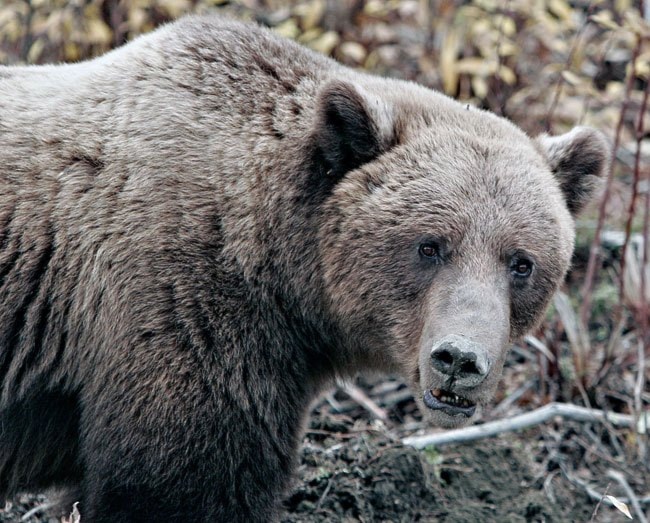There will be a review of roadside hunting in the Yukon.
Environment Minister Currie Dixon has requested the Yukon Fish and Wildlife Management Board and Environment Yukon create a working group to consider how to reduce conflict between roadside hunting and wildlife viewing.
The group will be formed after the board holds its annual meeting next week, said chair Harvey Jessup.
The shooting of a blonde grizzly bear along the Tagish Road late last month has sparked a public debate over roadside hunting. As it stands, hunters are allowed to shoot animals as long as they are completely off the road - including paved shoulders - and are shooting away from the road. They also have to be one kilometre from any residence.
Some Carcross residents have condemned the killing. The bear had lived in the area for several years, and residents and tourists alike enjoyed watching the bear eat honeysuckle along the side of the road.
“(The hunter) followed the rules,” Carcross resident Greg Karais told the News, noting the shooting was legal. “But if those are the rules, in my opinion, those rules need to change.” He started a Facebook page to give people a space to discuss the topic.
But this shooting didn’t prompt the group’s creation, said Jessup. Concern over the ethics of roadside hunting has been growing for years.
Last year, Environment Yukon recommended banning bear hunting along the Atlin Road for safety and conservation purposes.
But the fish and wildlife management board rejected this. Instead, it proposed the board and the government work together to address roadside hunting throughout the territory. In response, the minister requested a working group be formed.
There are already bans on roadside hunting in other places in Yukon, including along the Annie Lake Road, the Takhini Hot Springs Road and the Meister logging road. The hunting of most big game, like bears, wolves and elk, is prohibited along the Dempster Highway, but this restriction doesn’t apply to caribou. There’s also a ban on hunting one kilometre from the Alaska Highway between the Slims River Bridge and the Yukon-Alaska Border. This is because there were concerns construction workers would hunt moose in the area, said Jessup.
But the board looks at the territory as whole, not just specific areas, said Jessup.
“Yesterday, it was the Atlin Road. Today, it could be the Tagish Road. Tomorrow it could be another road,” he said. “Instead of trying to second guess where the next issue might arise, perhaps it would be prudent to look at it from a more holistic approach.”
Details of the working group’s composition haven’t yet been worked out, but it will include representatives from the government and the board, said Jessup.
The group could start asking the public about what they would like to see in hunting regulations this fall, said Jessup. The group would then collect what it heard, and make recommendations in the spring. Recommendations could include changing the law, he said. But if any laws were to be changed, they wouldn’t take effect until the spring of 2015, said Jessup.
While the board rejected banning bear hunting along the Atlin Road, it did suggest putting up signs that say the road is a good place for viewing bears. Dixon rejected that suggestion because putting up signs requires input from Highways and Public Works.
These recommendations came as part of the regular procedure for considering changes to the territory’s hunting and fishing rules. Each year, Environment Yukon and the Yukon Fish and Wildlife Management Board review any suggestions for changes in the spring. Public consultation happens in the fall. Then, the board forms recommendations and sends them to the minister of the environment to be approved, rejected or varied.
There were 11 changes recommended this year. The government supported all of them, but no cabinet orders have yet been made to turn the recommendations into law.
These changes include allowing youth aged 12 and 13 to use the adult-permit hunt authorization and seal as long as they’ve completed a hunter safety course and a licensed adult, older than 19, is with them. Permits are required to hunt moose, caribou, sheep, goat, deer or elk.
Wolf hunting will also see changes. The minister will be able to change the limits on how many wolves can be killed each year, and the season dates. In areas where wolf hunting is allowed, Yukon residents can kill seven wolves a year. Non-residents can kill two.
The Yukon’s wolf population is healthy right now, the board explained in its reasons for suggesting the change. The minister has to consult with First Nations, boards and councils before making the change. The government also accepted recommendations to remove the $10 sealing fee for killing wolves, and changing the date of when hunters need to report wolf kills to April 15.
The government also accepted a recommendation to reject Environment Yukon’s proposal to fine fishermen $100 for having barbed hooks attached to fishing lines when fishing in areas where such hooks aren’t allowed. The minister asked the board and department to further examine the issue.
The minister also accepted a recommendation to reduce the seal fee for elk from $50 to $10. The final recommended changes included making it mandatory to use a special guide when hunting bison, and revoking special guiding for grizzly bears. The minister also supported setting aside a proposal to limit the number of game birds non-residents can kill.
Contact Meagan Gillmore at
mgillmore@yukon-news.com
